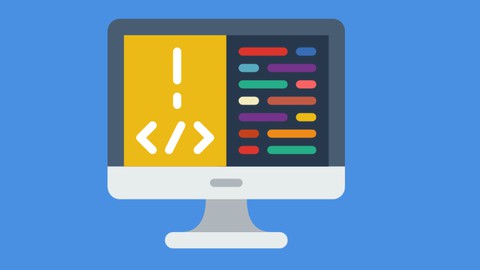
Programming for Beginners: (Python,HTML, CSS, JavaScript)
Programming for Beginners: (Python,HTML, CSS, JavaScript), available at $54.99, has an average rating of 3.17, with 229 lectures, based on 3 reviews, and has 17 subscribers.
You will learn about Understand the foundational concepts of web development Create well-structured and semantically meaningful web pages using HTML Apply CSS styling techniques to design visually appealing websites. Utilize JavaScript to add interactivity and dynamic functionality to web pages Grasp fundamental programming concepts such as variables, data types, and control structures in Python. Build desktop applications using Python Build web applications with HTML CSS JAVASCRIPT Learn the principles of object oriented programming with Python Learn about Python packages and modules Learn how to interact with external files using Python Learn to debug and handle errors in Python programming Learn GUI Programming with Python Learn web development and build web applications Learn Python programming from scratch. This course is ideal for individuals who are Absolute beginners with no prior coding experience who want to learn the fundamentals of web development and Python programming from scratch or Students or recent graduates considering a career in technology who want to build a strong foundation in programming skills. or Professionals from non-technical backgrounds who are looking to transition into roles involving web development or data analysis. or Entrepreneurs or small business owners who want to gain the skills to build and maintain their own websites or web applications. or Hobbyists and enthusiasts interested in exploring the world of programming as a creative outlet or intellectual pursuit. It is particularly useful for Absolute beginners with no prior coding experience who want to learn the fundamentals of web development and Python programming from scratch or Students or recent graduates considering a career in technology who want to build a strong foundation in programming skills. or Professionals from non-technical backgrounds who are looking to transition into roles involving web development or data analysis. or Entrepreneurs or small business owners who want to gain the skills to build and maintain their own websites or web applications. or Hobbyists and enthusiasts interested in exploring the world of programming as a creative outlet or intellectual pursuit.
Enroll now: Programming for Beginners: (Python,HTML, CSS, JavaScript)
Summary
Title: Programming for Beginners: (Python,HTML, CSS, JavaScript)
Price: $54.99
Average Rating: 3.17
Number of Lectures: 229
Number of Published Lectures: 229
Number of Curriculum Items: 229
Number of Published Curriculum Objects: 229
Original Price: $59.99
Quality Status: approved
Status: Live
What You Will Learn
- Understand the foundational concepts of web development
- Create well-structured and semantically meaningful web pages using HTML
- Apply CSS styling techniques to design visually appealing websites.
- Utilize JavaScript to add interactivity and dynamic functionality to web pages
- Grasp fundamental programming concepts such as variables, data types, and control structures in Python.
- Build desktop applications using Python
- Build web applications with HTML CSS JAVASCRIPT
- Learn the principles of object oriented programming with Python
- Learn about Python packages and modules
- Learn how to interact with external files using Python
- Learn to debug and handle errors in Python programming
- Learn GUI Programming with Python
- Learn web development and build web applications
- Learn Python programming from scratch.
Who Should Attend
- Absolute beginners with no prior coding experience who want to learn the fundamentals of web development and Python programming from scratch
- Students or recent graduates considering a career in technology who want to build a strong foundation in programming skills.
- Professionals from non-technical backgrounds who are looking to transition into roles involving web development or data analysis.
- Entrepreneurs or small business owners who want to gain the skills to build and maintain their own websites or web applications.
- Hobbyists and enthusiasts interested in exploring the world of programming as a creative outlet or intellectual pursuit.
Target Audiences
- Absolute beginners with no prior coding experience who want to learn the fundamentals of web development and Python programming from scratch
- Students or recent graduates considering a career in technology who want to build a strong foundation in programming skills.
- Professionals from non-technical backgrounds who are looking to transition into roles involving web development or data analysis.
- Entrepreneurs or small business owners who want to gain the skills to build and maintain their own websites or web applications.
- Hobbyists and enthusiasts interested in exploring the world of programming as a creative outlet or intellectual pursuit.
“Programming for Beginners: Building the Foundations” offers a comprehensive introduction to the world of web development and Python programming, catering to individuals with little to no prior experience in coding. Whether you’re aspiring to become a web developer, data analyst, or simply looking to gain valuable technical skills, this course equips you with the fundamental knowledge and practical experience needed to kickstart your journey in the dynamic field of programming.
Throughout the course, you will delve into the core technologies that power the modern web, including HTML, CSS, JavaScript, and Python. The journey begins with an exploration of HTML, the backbone of web development, where you’ll learn to create structured and semantically meaningful web pages. From there, you’ll progress to CSS, mastering the art of styling and layout to transform your HTML documents into visually appealing websites.
As your understanding of front-end development solidifies, you’ll venture into the realm of JavaScript, the language of interactivity and dynamism on the web. Through hands-on exercises and projects, you’ll discover how to manipulate the Document Object Model (DOM), respond to user interactions, and breathe life into your web pages with dynamic content and functionality.
In parallel, the course introduces you to the versatile programming language Python, known for its simplicity and readability. You’ll embark on a journey of logical thinking and problem-solving as you grasp Python’s syntax, data types, control structures, and functions. With Python as your tool, you’ll tackle coding challenges and explore real-world applications, from automating tasks to analyzing data and beyond.
Building on your newfound Python skills, the course seamlessly integrates backend development into your repertoire. You’ll learn to harness the power of Flask, a lightweight web framework, to create dynamic web applications with Python serving as the backend logic. By mastering concepts such as routing, templating, and handling requests, you’ll gain the confidence to build and deploy your own web applications from scratch.
Throughout the course, emphasis is placed on hands-on learning and project-based assessments. You’ll apply your skills to practical projects, including building a personal portfolio website that showcases your abilities and creativity. With guidance from experienced instructors and a supportive learning community, you’ll receive personalized feedback and guidance to ensure your success every step of the way.
By the end of “Programming for Beginners: Building the Foundations,” you’ll emerge with a solid understanding of web development principles, proficiency in HTML, CSS, JavaScript, and Python, and the confidence to pursue further learning and explore exciting opportunities in the ever-evolving world of technology. Join us on this transformative journey and unlock your potential as a programmer and web developer.
Course Curriculum
Chapter 1: Introduction to Programming
Lecture 1: Introduction
Lecture 2: Overview of programming and its importance.
Lecture 3: Introduction to programming languages and their types.
Lecture 4: High and low level programming languages
Lecture 5: Compilers and interpreters
Chapter 2: Python Development Environment Setup
Lecture 1: What is Python
Lecture 2: What is Jupyter Notebook
Lecture 3: Installing Jupyter
Lecture 4: Running Jupyter Notebook
Lecture 5: Jupyter Commands
Lecture 6: Jupyter Notebook Interface
Lecture 7: Create a new Jupyter Notebook
Lecture 8: Installing Python on Windows
Lecture 9: Installing Python3 on a Mac
Lecture 10: Installing Pycharm on Windows
Lecture 11: Installing Pycharm on a Mac
Lecture 12: How to change theme in Pycharm
Lecture 13: Pycharm Configuration on Windows Part 1
Lecture 14: Pycharm Configuration on Windows Part 2
Lecture 15: Pycharm configuration on a Mac
Lecture 16: Introduction to Plain Text Editors
Lecture 17: Installing SublimeText Editor
Lecture 18: Installing Visual studio code
Chapter 3: Python Programming Fundamentals
Lecture 1: Python Expressions
Lecture 2: Python Statements
Lecture 3: Python Comments
Lecture 4: Python Data Types
Lecture 5: Casting Data Types
Lecture 6: Python Variables
Lecture 7: Python List
Lecture 8: Python Tuple
Lecture 9: Python Dictionaries
Lecture 10: Python Operators
Lecture 11: Python Conditional Statements
Lecture 12: Python Loops
Lecture 13: Python Functions
Chapter 4: Object Oriented Programming with Python
Lecture 1: Introduction to OOP
Lecture 2: Creating a Class
Lecture 3: Instantiating a Class
Lecture 4: Modifying Classes
Lecture 5: Class and Instance Variables
Lecture 6: Inheritance Part 1
Lecture 7: Inheritance Part 2
Lecture 8: Inheritance Part 3
Lecture 9: Inheritance Part 4
Lecture 10: Polymorphism Part 1
Lecture 11: Polymorphism Part 2
Lecture 12: Polymorphism Part 3
Lecture 13: Encapsulation Part 1
Lecture 14: Encapsulation Part 2
Lecture 15: Encapsulation Part 3
Lecture 16: Abstraction Part 1
Lecture 17: Abstraction Part 2
Chapter 5: Python Modules and Packages
Lecture 1: What are Modules
Lecture 2: How to use a Module
Lecture 3: Built in Modules
Lecture 4: What are Python Packages
Lecture 5: Python dir Function
Lecture 6: Pycache Directory
Chapter 6: Working with External Files in Python
Lecture 1: Introduction to File Handling
Lecture 2: Opening and Reading External File Part 1
Lecture 3: Opening and Reading External File Part 2
Lecture 4: Appending and writting to external files
Lecture 5: Acessing File Object attributes
Lecture 6: Setting the File Pointer
Lecture 7: Renaming and Deleting External Files
Chapter 7: Handling Exceptions (Errors)
Lecture 1: Introduction to Python Exceptions
Lecture 2: Handling Exceptions
Lecture 3: Implementing basic exception handling -Part 1
Lecture 4: Implementing basic exception handling -Part 2
Lecture 5: Implementing basic exception handling -Part 3
Lecture 6: Handling exceptions and error messages.
Lecture 7: Debugging techniques and common errors.
Chapter 8: Introduction to Algorithms
Lecture 1: Understanding algorithms and their importance.
Lecture 2: Common algorithmic problems and solutions.
Lecture 3: Basic sorting and searching algorithms.
Chapter 9: Introduction to GUI Programming
Lecture 1: Introduction to graphical user interfaces (GUIs).
Lecture 2: Building simple GUI applications using Python libraries.
Lecture 3: Event-driven programming concepts.
Chapter 10: Python Project: Build an App to convert feet to meters
Lecture 1: What we will create
Lecture 2: Application design | sketch
Lecture 3: Create project directory and Python file
Lecture 4: Create app GUI – Part 1
Lecture 5: Create app GUI – Part 2
Lecture 6: Creating functions and testing the app
Lecture 7: Removing console from Python file
Lecture 8: Convert python code into an executable file
Lecture 9: Source code
Chapter 11: Python Project : Build a Currency Converter
Lecture 1: What we will create
Instructors
-
Digital Learning Academy
Digital learning 24 /7
Rating Distribution
- 1 stars: 0 votes
- 2 stars: 1 votes
- 3 stars: 1 votes
- 4 stars: 1 votes
- 5 stars: 0 votes
Frequently Asked Questions
How long do I have access to the course materials?
You can view and review the lecture materials indefinitely, like an on-demand channel.
Can I take my courses with me wherever I go?
Definitely! If you have an internet connection, courses on Udemy are available on any device at any time. If you don’t have an internet connection, some instructors also let their students download course lectures. That’s up to the instructor though, so make sure you get on their good side!
You may also like
- Top 10 Financial Technology Courses to Learn in December 2024
- Top 10 Agile Methodologies Courses to Learn in December 2024
- Top 10 Project Management Courses to Learn in December 2024
- Top 10 Leadership Skills Courses to Learn in December 2024
- Top 10 Public Speaking Courses to Learn in December 2024
- Top 10 Affiliate Marketing Courses to Learn in December 2024
- Top 10 Email Marketing Courses to Learn in December 2024
- Top 10 Social Media Management Courses to Learn in December 2024
- Top 10 SEO Optimization Courses to Learn in December 2024
- Top 10 Content Creation Courses to Learn in December 2024
- Top 10 Game Development Courses to Learn in December 2024
- Top 10 Software Testing Courses to Learn in December 2024
- Top 10 Big Data Courses to Learn in December 2024
- Top 10 Internet Of Things Courses to Learn in December 2024
- Top 10 Quantum Computing Courses to Learn in December 2024
- Top 10 Cloud Computing Courses to Learn in December 2024
- Top 10 3d Modeling Courses to Learn in December 2024
- Top 10 Mobile App Development Courses to Learn in December 2024
- Top 10 Graphic Design Courses to Learn in December 2024
- Top 10 Videography Courses to Learn in December 2024






















